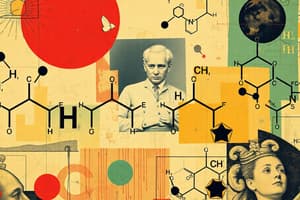Podcast
Questions and Answers
What prefix is used for a hydrocarbon chain with five carbons?
What prefix is used for a hydrocarbon chain with five carbons?
- Hex-
- Pent- (correct)
- Dec-
- Ter-
Which of the following functional groups does the suffix '-ane' refer to?
Which of the following functional groups does the suffix '-ane' refer to?
- Alkane (correct)
- Alcohol
- Carboxylic acid
- Alkene
In a substitution reaction, how many products are formed?
In a substitution reaction, how many products are formed?
- Two (correct)
- Four
- One
- Three
What is the displayed formula for ethane (C2H6)?
What is the displayed formula for ethane (C2H6)?
What type of organic reaction involves the addition of hydrogen to a compound?
What type of organic reaction involves the addition of hydrogen to a compound?
What are the products formed in a complete combustion reaction of hydrocarbons?
What are the products formed in a complete combustion reaction of hydrocarbons?
Which suffix indicates a compound is an alcohol?
Which suffix indicates a compound is an alcohol?
Which of the following represents an example of an alkene?
Which of the following represents an example of an alkene?
What defines a hydrocarbon?
What defines a hydrocarbon?
Which formula represents the simplest whole number ratio of each element in a compound?
Which formula represents the simplest whole number ratio of each element in a compound?
What term is used for a series of compounds that share the same general formula?
What term is used for a series of compounds that share the same general formula?
Which formula shows the arrangement of atoms within a molecule?
Which formula shows the arrangement of atoms within a molecule?
What is a functional group?
What is a functional group?
What does molecular formula represent?
What does molecular formula represent?
What phenomenon describes compounds having the same molecular formula but different structures?
What phenomenon describes compounds having the same molecular formula but different structures?
What prefix is used for a compound containing three carbon atoms?
What prefix is used for a compound containing three carbon atoms?
What type of formula would you use to show the covalent bonds between atoms in a compound?
What type of formula would you use to show the covalent bonds between atoms in a compound?
Which type of formula can represent any member of an entire class of compounds?
Which type of formula can represent any member of an entire class of compounds?
Flashcards are hidden until you start studying
Study Notes
Hydrocarbons
- Hydrocarbon is a compound of hydrogen and carbon only.
Representing Organic Molecules
- Empirical formula - The simplest whole number ratio of each element in a compound (e.g. for ethene = CH2)
- Molecular formula - Actual numbers of each element in a compound (e.g. for ethene = C2H4)
- General formula - A type of empirical formula that represents the composition of any member of an entire class of compounds (e.g. for ethene = CnH2n)
- Structural formula - Formula which shows the arrangement of atoms in the molecule of a compound (e.g. for ethene = CH2CH2)
- Displayed formula - Shows the symbols for each atom in a compound with straight lines representing covalent bonds
Homologous series, Functional Group, Isomerism
- Homologous series - Series of compounds with the same general formula and similar properties.
- Functional group - A group of atoms responsible for the chemical reactions of a compound.
- Isomerism - Compounds with the same molecular formula exist in different forms due to different arrangements of atoms (different forms of isomerism exist).
Naming Organic Compounds
- Prefixes (beginning of the name) -
- 1 carbon: Meth-
- 2 carbons: Eth-
- 3 carbons: Prop-
- 4 carbons: But-
- 5 carbons: Pent-
- 6 carbons: Hex-
- Suffixes (end of the name) - Suffixes refer to the functional group.
- Alkanes: ane (C-C // C-H) e.g. ethane
- Alkenes: ene (C=C) e.g. ethene
- Alcohols: ol (OH) e.g. ethanol
- Carboxylic acids: anoic acid (-COOH) e.g. ethanoic acid
Classifying Organic Reactions
- Addition reactions - 2 reactants → 1 product. An atom is added onto the molecule, commonly added to double bonds.
- e.g. addition of hydrogen to ethene to produce ethane (H2 is added onto C=C to form H-C-C-H)
- Substitution reactions - 2 reactants → 2 products. An atom in a molecule is replaced by a different atom.
- e.g. Hydrogen chloride + ethanol → chloroethane + water (Cl replaces OH - they switch places)
- Combustion reactions - A fuel reacts with OXYGEN. Only water and carbon dioxide are produced from hydrocarbons if combustion is complete.
Studying That Suits You
Use AI to generate personalized quizzes and flashcards to suit your learning preferences.




